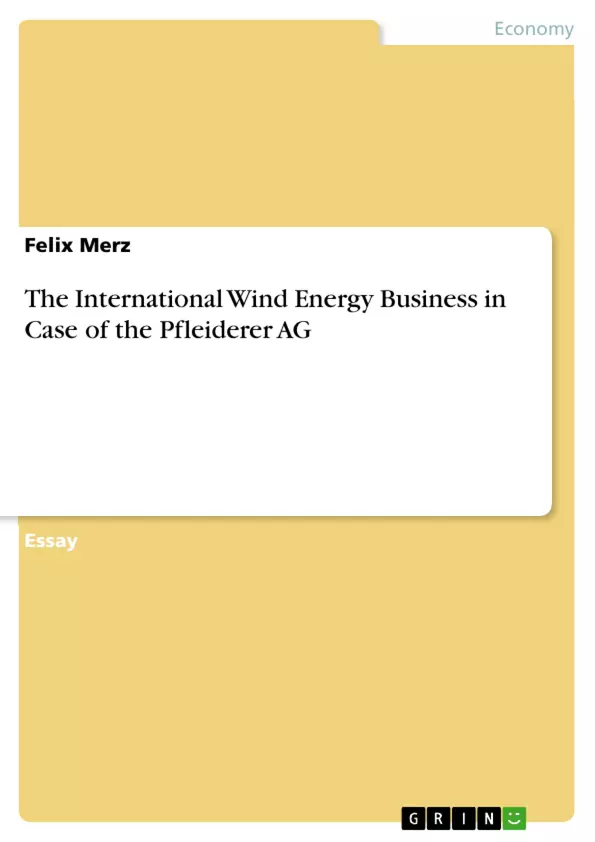The following report deals with generating electricity via wind energy converters, one of the latest renewable resources, which have been becoming increasingly import during the past years.
One of the worldwide leading, diversified and international company within the business is the “Pfleiderer AG”. The company employs 5800 people (in 2007) and distinguished their business in two units: derived timber products and infrastructure systems. The first one produces decorative plates, high pressure laminates and post forming elements for interior settings. This unit obtains about 52% of the volume abroad. The wind energy business is included in infrastructure systems, in addition to poles and towers and track systems. “Pfleiderer Wind Energy GmbH”, 100% subsidiary, develops and sells complete wind energy converters. In summer of 2000, the company acquired the Austrian “Windtec” to gain necessary expertise.
The long‐term goal is to hold a proper position in the growing offshore‐market in the coming years.
Inhaltsverzeichnis (Table of Contents)
- Introduction
- Chapter One
- What are the driving forces behind the wind energy business?
- Is the WEC business attractive?
- What are the major changes and tendencies within the business and what are the reasons for these changes?
- Chapter Two
- How could Pfleiderer compete within the wind energy business?
- What are the distinct resources, and which weaknesses does the company have to overcome?
- From the resource perspective, which criteria are most important to Pfleiderer when selecting a new market?
- Chapter Three
- Which foreign market offers the best conditions for entry?
- What decision model should we use when selecting a market?
- Conclusion
Zielsetzung und Themenschwerpunkte (Objectives and Key Themes)
This report explores the wind energy industry and its growth, with a particular focus on the Pfleiderer AG company. The main objective is to analyze the factors driving the wind energy business, identify the strengths and weaknesses of Pfleiderer, and assess the potential of different foreign markets for the company's expansion.- Driving forces behind the wind energy business
- Pfleiderer's competitive advantage and weaknesses in the wind energy market
- Market selection criteria for Pfleiderer's international expansion
- Attractiveness of foreign markets for wind energy businesses
- Decision models for market selection in the wind energy industry
Zusammenfassung der Kapitel (Chapter Summaries)
Chapter One
Chapter One explores the driving forces behind the growth of the wind energy business. It highlights the importance of the Kyoto Protocol in promoting renewable energy sources and reducing greenhouse gas emissions. The chapter also discusses the diminishing availability of fossil fuels and the increasing awareness of global warming as major factors driving the shift towards wind energy.Chapter Two
This chapter focuses on Pfleiderer AG, examining its strengths and weaknesses within the wind energy business. It analyzes the company's resources, expertise, and potential areas for improvement to compete effectively in the market. The chapter also addresses the criteria that Pfleiderer should prioritize when selecting new markets for expansion.Chapter Three
Chapter Three examines the selection of foreign markets for Pfleiderer's wind energy business. It explores the criteria for identifying the most promising markets based on factors such as regulatory frameworks, market size, and potential for growth. The chapter also presents a decision model for selecting the most suitable market for entry.Schlüsselwörter (Keywords)
This report delves into the wind energy industry, highlighting key drivers such as the Kyoto Protocol, renewable energy, global warming, and the need for sustainable energy solutions. It focuses on Pfleiderer AG, examining its strengths, weaknesses, and strategic approach to entering foreign markets. The analysis emphasizes the importance of market selection criteria, competitive advantages, and decision models for successful international expansion in the wind energy sector.- Quote paper
- Dipl.-Betriebswirt (FH) Felix Merz (Author), 2008, The International Wind Energy Business in Case of the Pfleiderer AG, Munich, GRIN Verlag, https://www.grin.com/document/179492



